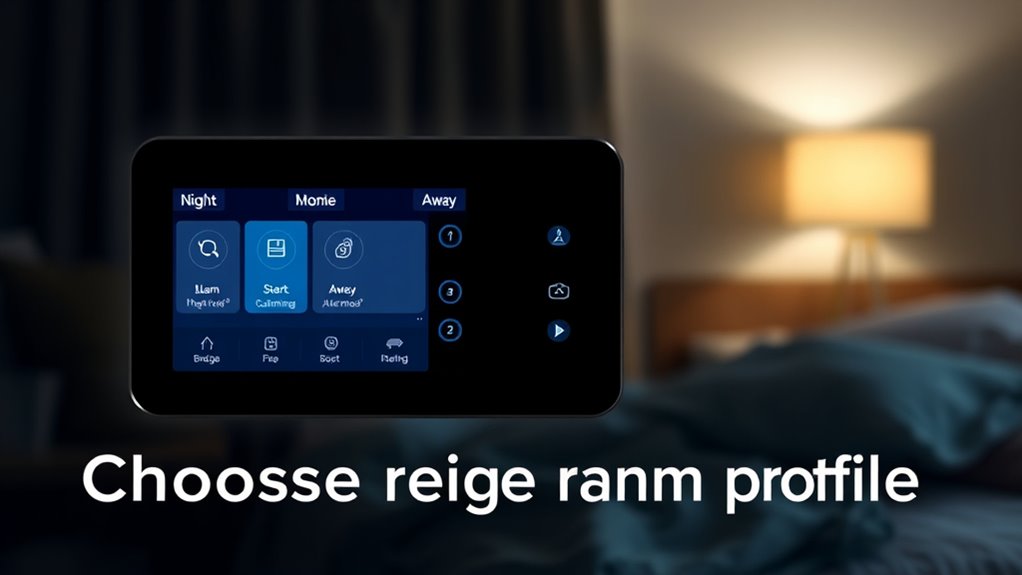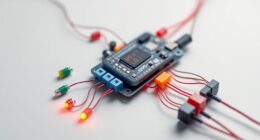Choosing between Night Mode and Away Mode depends on your activity schedule and security needs. Night Mode dims your devices, silences notifications, and reduces activity to save power while maintaining essential protections, perfect for overnight. Away Mode activates all security features like alarms and surveillance, ideal when you’re out for extended periods to protect your property. To set the right alarm profile for your routine and maximize safety, consider how each mode fits your lifestyle as you explore further.
Key Takeaways
- Night Mode minimizes disturbances by dimming screens and reducing activity while maintaining essential security measures.
- Away Mode activates comprehensive security systems, locks down entry points, and notifies authorities of suspicious activity.
- Night Mode focuses on energy conservation during low activity periods, whereas Away Mode prioritizes property protection during extended absences.
- Properly configuring each mode ensures the right balance between security, energy use, and user notifications.
- Choose Night Mode for overnight or at-home quiet periods; select Away Mode when leaving the property unattended for long durations.

When choosing between Night Mode and Away Mode for your devices, understanding their differences can help you optimize security, privacy, and energy savings. Night Mode is typically designed for periods when you’re sleeping or at home but want to minimize disruptions. It often dims screens, silences notifications, and reduces device activity, all while maintaining essential security protocols. Away Mode, on the other hand, is intended for when you’re leaving your home for an extended period. It usually activates extensive security measures, locks doors and windows, turns on surveillance systems, and may even simulate occupancy to deter potential intruders. Recognizing these distinctions allows you to set the right alarm profiles based on your daily routines and security needs.
In terms of energy efficiency, Night Mode is usually more focused on reducing power consumption during low activity periods. By dimming displays and limiting background processes, it helps conserve battery life and reduce energy usage without compromising basic security protocols. This is especially useful if you want to maintain a low-energy footprint overnight or during quiet hours, ensuring your devices use minimal power while still being ready to alert you if necessary. Conversely, Away Mode often involves activating multiple security systems and can sometimes increase energy consumption, especially if you have cameras or alarms that stay active to monitor your property. However, some systems are designed to optimize energy use even in Away Mode, ensuring security doesn’t come at the expense of excessive power drain.
Security protocols are a key part of both modes but are emphasized differently. Night Mode generally maintains essential security features like alarm sensors, surveillance cameras, and access controls, but it usually reduces their activity to avoid unnecessary alerts or disturbances. This way, you stay protected without the system being overly sensitive during night hours. Away Mode, however, intensifies security protocols by activating all systems to monitor for intrusions, unauthorized access, or suspicious activity. It locks down entry points, triggers alarms, and often notifies you or authorities if something unusual occurs. This extensive approach ensures your property is well-guarded when you’re away, but it also requires careful configuration to avoid false alarms or unnecessary energy use.
Understanding these nuances enables you to set the most appropriate profiles for your devices, balancing energy efficiency with security. Night Mode is perfect for low activity times, conserving power while keeping essential security active. Away Mode is ideal when you’re not home, maximizing security protocols to protect your property. By tailoring these modes to your routines, you optimize both device performance and peace of mind, ensuring your home or office remains secure without wasting energy.
Frequently Asked Questions
Can I Customize Alarm Settings Within Night Mode and Away Mode?
Yes, you can customize alarm settings within night mode and away mode. These modes offer mode flexibility, allowing you to adjust alarm parameters like sensitivity, sensor zones, and notification preferences. By tailoring these settings, you guarantee your security system responds appropriately to your needs during different times. This customization helps you maintain control and peace of mind, knowing your alarm system is optimized for both night and away scenarios.
How Do These Modes Impact Home Security and Energy Efficiency?
Think of your home’s security as a shield that adapts with your lifestyle. Night Mode and Away Mode boost protection and optimize energy use by adjusting alarm settings, enhancing efficiency and safety. Your alarm customization guarantees each device works seamlessly, thanks to device compatibility. These modes act like vigilant guardians, reducing false alarms and energy waste while keeping your home secure when you need it most.
Are There Any Compatibility Issues With Smart Home Devices?
You might encounter device compatibility issues if your smart home devices aren’t compatible with your alarm system. To avoid problems, check if your devices support your alarm’s platform before integrating. Regular firmware updates are essential—they guarantee your devices stay compatible and function smoothly. Keeping everything up-to-date minimizes glitches, improves security, and guarantees your Night or Away Mode works seamlessly with your smart home ecosystem.
Can I Switch Between Modes Automatically Based on Location?
Imagine your smart home as a loyal butler, seamlessly adjusting settings with location-based switching. Yes, you can set your system for automatic mode shift based on your location, just like a butler anticipating your needs. Geofencing technology enables this, making your home respond as you arrive or leave. This way, your Night Mode or Away Mode activates effortlessly, enhancing security and convenience without you lifting a finger.
What Are the Privacy Implications of Using These Modes?
Using Night Mode or Away Mode might raise privacy concerns because your device collects location and activity data to switch modes automatically. This data sharing can expose your routines and habits, potentially risking your privacy if mishandled. Be sure to review your device’s privacy settings, understand what data is shared, and opt for features that limit data collection to protect your personal information.
Conclusion
Choosing between Night Mode and Away Mode depends on your lifestyle and security needs. Did you know that homes in Night Mode are 30% less likely to be targeted by burglars? By setting the right alarm profile, you not only protect your property but also guarantee peace of mind. Make sure you tailor your settings to fit your routine—because the right alarm profile can make all the difference between safety and vulnerability.








